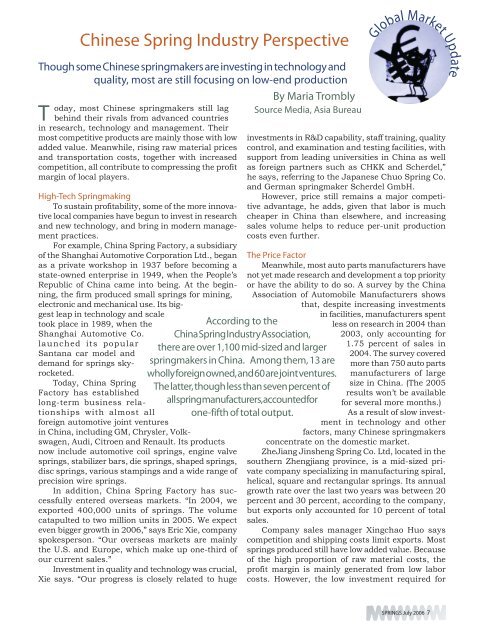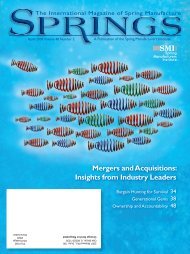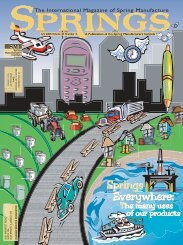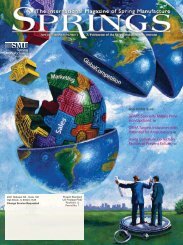Solid Height - Spring Manufacturers Institute
Solid Height - Spring Manufacturers Institute
Solid Height - Spring Manufacturers Institute
You also want an ePaper? Increase the reach of your titles
YUMPU automatically turns print PDFs into web optimized ePapers that Google loves.
T oday,<br />
Chinese <strong>Spring</strong> Industry Perspective<br />
Though some Chinese springmakers are investing in technology and<br />
quality, most are still focusing on low-end production<br />
most Chinese springmakers still lag<br />
behind their rivals from advanced countries<br />
in research, technology and management. Their<br />
most competitive products are mainly those with low<br />
added value. Meanwhile, rising raw material prices<br />
and transportation costs, together with increased<br />
competition, all contribute to compressing the profit<br />
margin of local players.<br />
High-Tech <strong>Spring</strong>making<br />
To sustain profitability, some of the more innovative<br />
local companies have begun to invest in research<br />
and new technology, and bring in modern management<br />
practices.<br />
For example, China <strong>Spring</strong> Factory, a subsidiary<br />
of the Shanghai Automotive Corporation Ltd., began<br />
as a private workshop in 1937 before becoming a<br />
state-owned enterprise in 1949, when the People’s<br />
Republic of China came into being. At the beginning,<br />
the firm produced small springs for mining,<br />
electronic and mechanical use. Its big-<br />
gest leap in technology and scale<br />
took place in 1989, when the<br />
Shanghai Automotive Co.<br />
launched its popular<br />
Santana car model and<br />
demand for springs skyrocketed.<br />
Today, China <strong>Spring</strong><br />
Factory has established<br />
long-term business relationships<br />
with almost all<br />
foreign automotive joint ventures<br />
in China, including GM, Chrysler, Volkswagen,<br />
Audi, Citroen and Renault. Its products<br />
now include automotive coil springs, engine valve<br />
springs, stabilizer bars, die springs, shaped springs,<br />
disc springs, various stampings and a wide range of<br />
precision wire springs.<br />
In addition, China <strong>Spring</strong> Factory has successfully<br />
entered overseas markets. “In 2004, we<br />
exported 400,000 units of springs. The volume<br />
catapulted to two million units in 2005. We expect<br />
even bigger growth in 2006,” says Eric Xie, company<br />
spokesperson. “Our overseas markets are mainly<br />
the U.S. and Europe, which make up one-third of<br />
our current sales.”<br />
Investment in quality and technology was crucial,<br />
Xie says. “Our progress is closely related to huge<br />
By Maria Trombly<br />
Source Media, Asia Bureau<br />
According to the<br />
China <strong>Spring</strong> Industry Association,<br />
there are over 1,100 mid-sized and larger<br />
springmakers in China. Among them, 13 are<br />
wholly foreign owned, and 60 are joint ventures.<br />
The latter, though less than seven percent of<br />
all spring manufacturers, accounted for<br />
one-fifth of total output.<br />
Global Market Update<br />
investments in R&D capability, staff training, quality<br />
control, and examination and testing facilities, with<br />
support from leading universities in China as well<br />
as foreign partners such as CHKK and Scherdel,”<br />
he says, referring to the Japanese Chuo <strong>Spring</strong> Co.<br />
and German springmaker Scherdel GmbH.<br />
However, price still remains a major competitive<br />
advantage, he adds, given that labor is much<br />
cheaper in China than elsewhere, and increasing<br />
sales volume helps to reduce per-unit production<br />
costs even further.<br />
The Price Factor<br />
Meanwhile, most auto parts manufacturers have<br />
not yet made research and development a top priority<br />
or have the ability to do so. A survey by the China<br />
Association of Automobile <strong>Manufacturers</strong> shows<br />
that, despite increasing investments<br />
in facilities, manufacturers spent<br />
less on research in 2004 than<br />
2003, only accounting for<br />
1.75 percent of sales in<br />
2004. The survey covered<br />
more than 750 auto parts<br />
manufacturers of large<br />
size in China. (The 2005<br />
results won’t be available<br />
for several more months.)<br />
As a result of slow investment<br />
in technology and other<br />
factors, many Chinese springmakers<br />
concentrate on the domestic market.<br />
ZheJiang Jinsheng <strong>Spring</strong> Co. Ltd, located in the<br />
southern Zhengjiang province, is a mid-sized private<br />
company specializing in manufacturing spiral,<br />
helical, square and rectangular springs. Its annual<br />
growth rate over the last two years was between 20<br />
percent and 30 percent, according to the company,<br />
but exports only accounted for 10 percent of total<br />
sales.<br />
Company sales manager Xingchao Huo says<br />
competition and shipping costs limit exports. Most<br />
springs produced still have low added value. Because<br />
of the high proportion of raw material costs, the<br />
profit margin is mainly generated from low labor<br />
costs. However, the low investment required for<br />
SPRINGS July 2006 7





